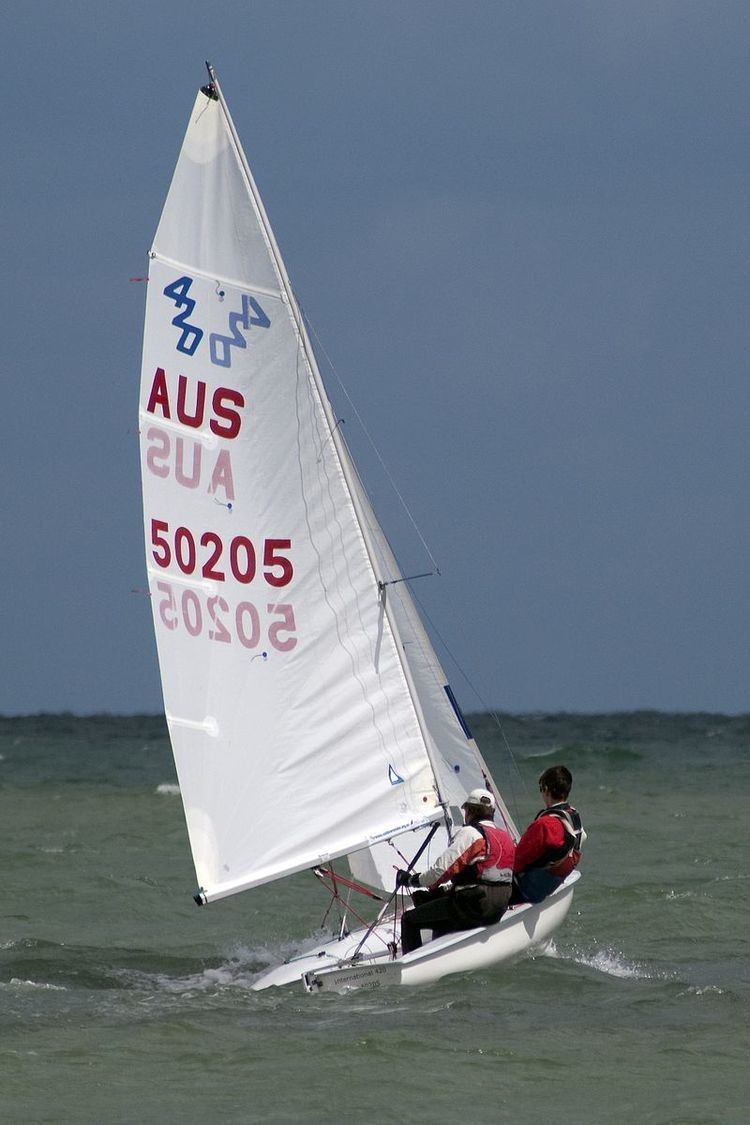Designer Christian Maury Design One-Design Crew 2 | Year 1959 Role Youth trainer, racing | |
 | ||
Draft 0.965 metres (3 ft 2.0 in) | ||
The International 420 Class Dinghy (not to be confused with the Club 420) is a double-handed (2 crew) monohull planing dinghy with centreboard, bermuda rig and center sheeting. The name describes the overall length of the boat in centimeters (the boat is exactly 4.2 meters long). The hull is fiberglass with internal buoyancy tanks. The 420 is equipped with spinnaker and optional trapeze, making teamwork necessary to sail it well. It has a large sail-area-to-weight ratio, and is designed to plane easily. It can be rigged to be sailed single-handed.
Contents
The 420 was designed specifically to be easier to handle than its larger higher-performance cousin, the 470. The 420 was designed by French engineer Christian Maury, as a stepping-stone for club and youth sailing to the 470. The 420 is an International class recognized by the International Sailing Federation.
A derivative of the 420 called the Club 420 is popular in the North America. This class is not recognised by International Sailing Federation or the International 420 Class Association and cannot be used at class events. The boats are very similar in appearance but the Club 420 is slightly stronger, heavier and less refined.
History
The International 420 was designed by Christian Maury, after a specification drawn by Aristide Lehoerrff and Pierre Latxague, chief sailing instructors of the Centerport sailing school South-West France near St Jean de Luz. It was built at first by French industrialist Lucien Lanaverre, a former cooper for the Bordeaux wine industry, who had converted to the then new industry of GRP polyester moulding in the 1960s as an inexpensive general purpose two sail, transom sheeted, non-trapeze dinghy, with modest easily handled sail plan. The class developed rapidly in France, being adopted nationally as a youth trainer for the larger Olympic class International 470 which was designed by André Cornu. By the late 1960s the class was adopted by a few UK university sailing clubs for training and team racing. It has the famous Bermuda rig.
Construction
The class adopted a policy of "prudent evolution" so as to allow development without making existing dinghies obsolete. The hull's seaworthiness and stability at speed proved to be better than most of its contemporaries, and this together with its modest sail area make it fun to sail in heavy weather and thus an excellent youth trainer, qualities that led to its adoption for that role by the RYA in the mid-1970s.
With its trapeze and spinnaker it provides the capability for advanced sailing techniques for international standard sailors, while still remaining affordable and accessible to beginners. The International 420 maintains a large multinational class association. The combination of effective class management, the boat's inherent sailing qualities, and prudent evolution have contributed to the class's continuing success.
420 Team Racing World Championships
The boat has been used for team racing in both the ISAF Team Racing World Championship and the ISAF World Sailing Games however the class established it own team racing competition in 2015. Only the International 14 and Optimist (dinghy) class hold also hold a team racing based World Championships.
ISAF Youth Worlds
The class has been used for almost all the ISAF Youth Sailing World Championships as the two person dinghy for boys and girls. For a couple of years the class was competing for the slot with both the 29er and Laser 2. The Laser 2 is no longer recognised equipment for the youth worlds and the 29er has been recognised separately for the skiff discipline.
